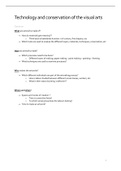Technology and conservation of the visual arts
Question
What are artworks made of?
→ How do materials get meaning??
o Think back at beeldende kunsten: rich colours, fine drapery, etc
→ Which tools are used to analyse the different layers, materials, techniques, conservation, etc
How are artworks made?
→ Which processes need to be done?
o Different layers of making: paper making – paint making – painting – framing
→ What techniques are used to examine processes?
Who makes the artworks?
→ Which different individuals are part of the artmaking process?
o How is labour divided between different social classes, workers, etc
o What is their status by being ‘craftsmen’?
Where and when?
→ Spaces and routes of creation ?
o Time is a sensitive factor!
o To which social group does the labours belong?
→ Time to make an artwork?
1
,PAPER MAKING
“WHERE IS PAPER MADE?”
It all started in China!
Paper was originally invented in South-East Asia, especially in China by the Han dynasty dating back
to the 2nd century BC. The eldest findings date back to the 2nd century BC. The origin of the paper
made its way from China to North-Africa, and eventually via this way to Europe.
→ The ‘way of making’ is a theory in practice, that originally got its name from ancient Greece
→ Western Europe didn’t make paper for a long time, but did import it from Northern Africa
o Muslim world only at the 8th century
This exchange is made because of war: the battle of Talas (751 AD). China
lost and was forced to hand over its riches and knowledge
o It reaches Tunisia and Morocco in the 10th century, and Fez in the 11th century
o Spain will be the first European country to make paper itself in the ±10th century
Paper Mills open first in Andalusia, later spread to the Northern region
Craft was divided mostly by merchants and tradesmen, reached Italy in 12-
13th century and France in the 14th
Paper will now be made in the “Fabirano Paper Mill”, Italic invention of the
first hydraulic powered paper mill. This one had a more desirable product
and would soon be used in ‘molines’, = papermills close to regions where a
lot of paper was needed (big cities, college towns, etc)
“HOW IS PAPER MADE?”
Its made in a mill, close to a lot of (running) water. This water must be pure, transparent and
without too much iron (so good quality), this means the mills were to be far enough away from cities
as to not have pollution in the water – but also not too far for commercial reasons. One part of the
water is filtered in a series of barrels, and will be used for the stamping machines – the other part of
the water is used to activate the mills wheels with hydraulic power (didn’t have to be as clean!).
The raw materials in Europe were rags, apart from the vegetable coils of Asia and Africa.
These rags were made from flax of hemp, most commonly a mixture of both. Cotton fabrics were not
used for papermaking because it was, at the time until 19th c, a fairly rare product in Europe and
therefore not often used.
2
,Plants used for the making of paper
→ Old Chinese materials:
- Hemp - Nettle - Seaweed
- Bamboo - Mulberry - Rice straw
→ Change in North-African materials:
- Rags - Cloth
→ Didn’t have the same sources (trees) as they did in Asia, made paper much whiter by
having to use a different process (new sort of papermaking!)
→ First European materials:
- Rags - Cloth
→ Excess of availability from these materials because of the ‘silk road’, on which
merchants from all over the old world came and went to trade their fineries
→ Today’s materials:
- Wood
→ After the disappearance of traditional papermaking in the 18th century, industrial
processes done with steam driven machines were put to work to reduce the price of
labour. Linens also became more ‘rare’, and so those cost also went up too high for
normal produce
COLOURED PAPER:
Pigment mixed with bone powder, to give the finished paper a colour OR earlier during the process,
during the stamping phase, where pigments were directly added into the paper paste. Here again,
blue was one of, if not the, most expensive colours! Blue paper was initially used in Venice. The blue
allows artists to have more depth perception, both for drawing and printing.
3
, The original Chinese process:
1. The inner bark was cut and peeled into thin straps
2. These were left to macerate until they were completely soft
3. When they were completely dried, they were burned to ashes so that all the fibres got
broken down
4. Water was again added to create a thick, homogenous paste
5. This paste was combined with lime and then placed into a big container
→ Calcium from limestone, not the fruit! This inorganic material added to help the
process of fermentation to break away the fibres of the cellulose!
→ This also prevented the paper from turning yellow, and therefore gave it its white
colour – this was because it ‘cleaned’ the rags and therefore made a cleaner, finer
end result that wouldn’t be possible without adding this specific component
6. A thin mould will be placed into the container, which will take out a small amount of
substance
7. This sieving process will then be resumed b squeezing out all the water
8. Is then laid out to dry in the sun (out of its mould) as to dry it completely
4




